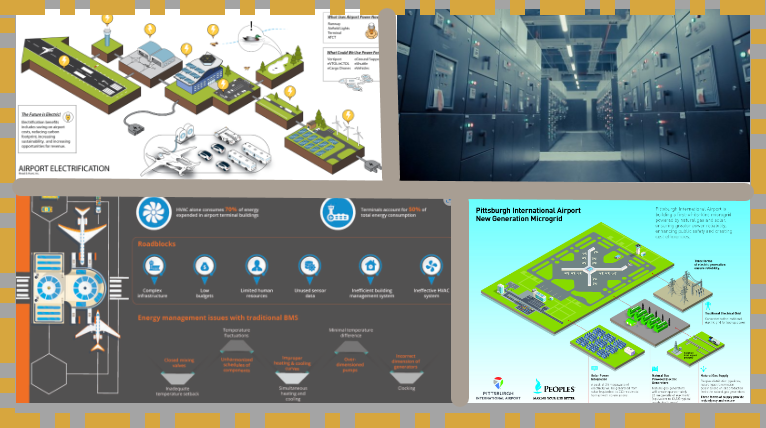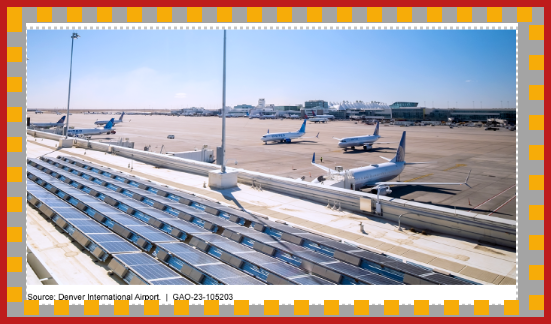Airport Electricity Resilience flagged by GAO and address by MWAA/Dominion Electric


Airports are large business enterprises housing the airlines, other aircraft, AIR TRAFFIC CONTROL systems (powering towers and navigational systems), vendors, baggage handling, the facility management and others dependent on electricity. As the GAO Report (below) found that THESE SYSTEMS CAN AND ARE DISRUPTED WITH ECONOMIC DAMAGES. The second article announces that the Metropolitan Washington Airports Authority and Dominion Energy have broken ground for the LARGEST US RENEWABLE ENERGY FARM AT AN AIRPORT, a relationship which also results in additional electrically powered vehicles.
The GAO Report is filled with excellent analyses and advice about (1) electrical infrastructure assessments, (2) undertaking projects to improve electrical infrastructure, and (3) installing equipment to generate additional backup power. The extensive research, tables and lists of strategies are worthy of careful consideration by all airport professionals.
The WMAA press release announces that with its partner, Dominion Electric, a new solar farm will be developed and will produce enough electricity to power not only IAD, but surplus energy will be used by the airport’s neighbor. The creativity and breadth of this transaction are ground-breaking in this arena.
Such initiative should not surprise because the US airport profession appears to be extraordinarily sophisticated with tremendous support from the FAA, the airports associations (AAAE, ACI) and research organizations (TRB, ACRP). Here is a sample of their studies on airport electrification resiliency:
- Interdependencies in Civil Infrastructure Systems
- Incorporating Resilience into Transportation Planning and Assessment
- Preparing your airport for electrical and hydrogen aviation
- Airports and Industry Release Guidance and Practical Examples to Expand Use of Electric Ground Service Equipment
- ACI World launches inaugural sustainability strategy report for airports worldwide
- AIRPORTS’ RESILIENCE AND ADAPTATION TO A CHANGING CLIMATE
- U.S. Releases First-Ever Comprehensive Aviation Climate Action Plan to Achieve Net-Zero Emissions by 2050
- Airport Resiliency
- Sustainability & Resiliency
The Volpe Center has had an assignment from DOT/FAA since 2021. That study has resulted in a Resilience Analysis Framework that assists airports and their consultants with conducting repeatable and effective resilience assessments during typical master planning processes. The framework will address criteria for projected impacts on pavement, drainage, and electrical systems performance over varying timescales and scenarios.
With such a library of reference materials and an industry faculty of first rate researchers the US Airport management profession is well armed to deal with the threats of climate change to electricity resilience. With such resources embedded in American Airport, the prompt action by MWAA reflect such preparedness. Privatization has been the panacea to all airport problems. The plethora of P3 projects overseas, but not in the US, may signal the excellence of our airport leaders.
Airport Infrastructure: Selected Airports’ Efforts to Enhance Electrical Resilience

Fast Facts
A power outage can significantly disrupt an airport’s operations. One 2017 outage at Hartsfield-Jackson Atlanta International Airport led to about 1,200 cancelled flights and cost an airline around $50 million.
Many of the nation’s airports are enhancing their ability to withstand and rapidly recover from power disruptions. They’re improving their electrical infrastructure, including installing backup generators or solar panels. Some airports are also considering installing microgrids—systems that independently generate, distribute, and store power. The FAA is offering new and expanded grant programs to help fund these projects.
Solar panels at Denver International Airport


What GAO Found
Twenty-four of the 30 commercial service airports that responded to GAO’s survey and interviews reported experiencing a total of 321 electrical power outages—i.e., an unplanned loss of power lasting 5 minutes or longer—from 2015 through 2022. Eleven of these airports reported having six or more outages over this 8 year period. Airports reported that these outages affected a range of airport operations and equipment (see table). Not all responding airports were able to provide detailed information about their outages, and some provided estimates about affected activities.
Reported Effects of a Portion of Electrical Power Outages on Selected Airport Activities and Equipment, 2015-2022 (percentage of outages)
| Airport activity or equipment affected | Yes | No | Don’t know |
| Baggage handling | 34% | 30% | 35% |
| Concessions | 22% | 26% | 50% |
| Other (e.g., automated people movers, escalators) | 18% | 9% | 15% |
| Gate/boarding | 16% | 34% | 49% |
| Check-in/ticketing | 16% | 33% | 50% |
| Parking | 14% | 34% | 52% |
| Communications | 13% | 32% | 54% |
| Flight delays & cancellations | 11% | 30% | 59% |
Source: GAO analysis of airport survey responses. | GAO-23-105203
Note: Airports provided responses on whether outages affected specific airport activities or equipment for 114 of the 321 electrical power outages, with the exception of flight delays and cancellations, for which information was provided for 119 outages. Percentages may not add up to 100 due to rounding or missing responses. For more details, see table 1 in GAO-23-105203.
Selected airports reported taking several actions to improve the electrical power resilience of their airports, including (1) conducting ELECTRICAL INFRASTRUCTURE ASSESSMENTS, (2) undertaking projects to IMPROVE ELECTRICAL INFRASTRUCTURE, and (3) INSTALLING EQUIPMENT TO GENERATE ADDITIONAL BACKUP POWER. For example, 40 of the 41 airports GAO interviewed reported planning or completing an infrastructure project to increase electrical power resilience. Of these, four airports reported installing microgrids. Such microgrid systems are capable of independently generating, distributing, and storing power.
The Federal Aviation Administration (FAA) is administering new and expanded grant programs and issuing guidance to support airports’ electrical resilience efforts. For example:
- Airport Improvement Program funding eligibility was expanded to include the Energy Supply, Redundancy, and Microgrids Program projects, which may include certain electrical power resilience projects.
- The new Airport Terminal Program provides funding for airport terminal development projects, including those that may strengthen resilience.
- FAA issued program guidance and conducted airport outreach to help increase airports’ awareness of available federal funding for resilience projects.
……………………..
For more information, contact Heather Krause at (202) 512-2834 or KrauseH@gao.gov.
Metropolitan Washington Airports Authority breaks ground on renewable energy project


BY LIZ CAREY | AUGUST 24, 2023 | AIR
On Tuesday, the Metropolitan Washington Airports Authority (MWAA) joined Dominion Energy in breaking ground on the LARGEST RENEWABLE ENERGY PROJECT EVER DEVELOPED AT A U.S. AIRPORT.
MWAA said their one-of-a-kind agreement with Dominion would provide the airport with energy and renewably fueled vehicles, while helping the company generate energy for Virginia customers. The DULLES SOLAR AND STORAGE PROJECT at Dulles International Airport will generate up to 100 megawatts (MW) of solar energy and store up to 50 MW of power, Dominion said. That’s enough to power more than 37,000 Virginia homes.
Additionally, as part of the lease agreement between the two entities, Dominion would develop two 1 MW solar carports that will partially power facilities at Dulles, as well as provide 18 electric transit buses, 50 electric fleet vehicles and a number of electric vehicle charging stations for operations at the airport.
“This partnership will result in the largest renewable energy project ever developed at a U.S. airport,” Jack Potter, President and CEO of MWAA, said. “It’s just one of many ways the Airports Authority is constantly working to be a good steward of the environment. We look forward to working with Dominion Energy to help provide emission-free electricity to serve the growing energy needs of the Dulles community and the National Capital Region.”

The project will be developed starting in late 2023 and is expected to be completed by late 2026. Construction on the project is expected to support more than 300 jobs and $200 million in economic activity.
“This is an exciting moment for the future of clean, reliable energy, not only for Virginia but for the entire nation,” Bob Blue, Chair, President and CEO of Dominion Energy, said. “Thanks to our strong partnership with MWAA, millions of travelers flying in and out of Dulles every year will see this powerful symbol of the clean energy transition. Just as air travelers can always count on Dulles to reach their destination, our customers can always count on us to deliver reliable and increasingly clean energy.”
